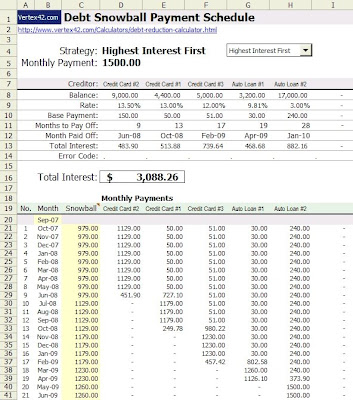
I love all things Excel, it's one thing Microsoft got right (even if they stole the idea from Lotus back in the day). Well there's a great website out there called Vertex 42.
--------------------------------------------------------------------
Debt Reduction Calculator - Download a free Debt Reduction spreadsheet for Excel from Vertex42.com.
Debt Reduction Calculator - Download a free Debt Reduction spreadsheet for Excel from Vertex42.com.
--------------------------------------------------------------------
Vertex 42 is dedicated to all things Excel and their site is loaded with live spreadsheets you can download. The debt eliminator I'm showing here is really slick and if you're in over your head with debt, it's a great tool to get a real handle on what you're up against and how to get out from under it. I know, I have been there and super-indebtedness stinks. It's easy to fall into the trap where you tell yourself that you can't get out from under what feel like insurmountable obstacles, but that's a lie. The first step toward taking control of your life is to get an accurate picture of what you're up against. Here's a great tool to help you do just that.

Vertex 42 is dedicated to all things Excel and their site is loaded with live spreadsheets you can download. The debt eliminator I'm showing here is really slick and if you're in over your head with debt, it's a great tool to get a real handle on what you're up against and how to get out from under it. I know, I have been there and super-indebtedness stinks. It's easy to fall into the trap where you tell yourself that you can't get out from under what feel like insurmountable obstacles, but that's a lie. The first step toward taking control of your life is to get an accurate picture of what you're up against. Here's a great tool to help you do just that.






